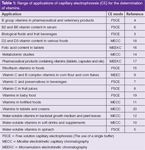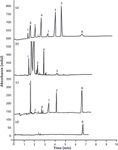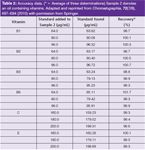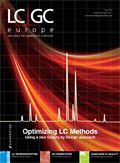Vitamin Analysis by Capillary Electrophoresis
This article discusses the role of CE for vitamin analysis and highlights a number of practical applications.
Capillary electrophoresis (CE) is useful in a range of applications because of its unique selectivity and potential to offer reduced sample pretreatment time and reagent costs. This article discusses the role of CE for vitamin analysis and highlights a number of practical applications.
Vitamins are a diverse range of essential dietary compounds (1). They are required in small amounts and are obtained primarily through diet and various vitamin supplements. Because vitamins are so crucial for good health, there is a wide range of fortified foods and supplements on the market which has given rise to the need for specific techniques to analyse them. Generally, vitamins are categorized as either water-soluble (C or B complex- B1, B2, B3, B5, B6, B8, B9 and B12) or fat-soluble (A, D, E and K). However, even in these groups they possess a wide range of functionalities: Some have acidic functions which allow separation by electrophoresis, while others have no charged functionality so require electro-chromatographic separation.
An earlier "CE Currents" article in 2003 (2) described application of CE to vitamin analysis. This article is an update and review of the applications of CE to vitamin analysis which have expanded considerably since the previous article.
Separation and Analysis Approaches
Free Solution CE (FSCE): A number of vitamins such as vitamin C (ascorbic acid) are water-soluble acids and so are good candidates for analysis by CE using high pH buffers (3–8). For example (3), vitamin C determination in fruit juices was performed on a 30 cm × 75 µm, fused-silica capillary column using 100 mM tricine buffer, pH 8.8, and measured by ultraviolet (UV) absorbance at 254 nm. Other suitable buffers include 20 mM tetraborate buffer which has a natural pH of 9.2 (4). If selectivity manipulation is required then additives such as cyclodextrin (0.025% HP-beta-CD) (7) can be used to give chromatographic interactions. Solvent additives such as 5% (v/v) acetonitrile can also be used (8) to alter selectivity and achieve the desired resolutions.
Micellar Electrokinetic Capillary Chromatography (MECC): A number of vitamins have no charge so require (9–14) chromatographic separation to achieve the required separations. Typically this may involve the use of a micellar high pH electrolyte such as (9) 20 mM NaH2PO4 containing 30 mM sodium dodecyl sulphate (SDS) as background electrolyte. In cases where extra selectivity is required then organic solvents such as acetonitrile (12) or methanol (12) can be added. Alternatively, a selectivity manipulating additive such as cyclodextrin (14) can be used to achieve the desired resolution.
MicroEmulsion Electrokinetic Chromatography (MEEKC): There are a number of parameters to adjust selectivity in MEEKC which include pH, oil type and concentration, surfactant and co-surfactant type and concentration, and the use of an organic solvent additive. For example, an optimal (17) microemulsion buffer for the separation of a range of vitamins contained 0.6% (w/w) sodium dodecyl sulphate (SDS) as surfactant, 1.2% (w/w) butan-1-ol as the co-surfactant, 0.5% (w/w) ethyl acetate as the oil and 82.7% (w/w) pH 9.2 tetraborate buffer, modified with 15% (v/v) 2-propanol.
Detection Principles: Typically UV absorbance detection is used.There are a number of vitamins, including the riboflavins, which have fluorescence properties and fluorescence detection can be used (15) for their detection with considerably improved sensitivity compared to UV absorbance detection.
A conductivity detector has also been used (7) to determine vitamin C in a range of preservatives (benzoate, sorbate and ascorbate) in beverages and vitamin C tablets. Additives, such as acetate and lactate, could also be determined (7).
Why Use CE for Vitamin Analysis?
The unique selectivity obtained by CE can allow complex samples to be analysed with reduced sample pre-treatment needs when compared to other analytical techniques, resulting in reduced time and cost of analysis. For example, water-soluble vitamins such as vitamin C can be directly analysed (3,8) with no pre-treatment or after a simple dilution with an internal standard solution.
The use of MECC, and more significantly MEEKC, allows simultaneous separation of a wide range of water-soluble and insoluble charged and neutral vitamins. The solubilizing power of the microemulsion used in MEEKC also allows rapid sample preparation because of its high solubilizing ability for both water-soluble and insoluble species. For example (17), oils and creams can be dissolved directly into microemulsion, facilitating very simple sample preparation.
Analysis times can also be rapid: For example a range of 8 water-soluble and insoluble vitamins can be analysed (17) using a MEEKC method in 7 min.
What are the Applications?
There is a wide and diverse range of applications for CE in vitamin analysis. A number of these are listed in Table 1.

Table 1: Range of applications of capillary electrophoresis (CE) for the determination of vitamins.
Vitamin C Content Determination in Drinks and Beverages: This application was the earliest application (1,8) of CE to vitamin analysis. A procedure to monitor citrus juice samples was established (1) to quantitate vitamin C by CE. Dilution and filtration were the only preparation requirements and separation was achieved with an uncoated capillary using a 35 mM sodium borate buffer (pH 9.3) containing 5% (v/v) acetonitrile at 21 kV and 23 °C. UV detection at 270 nm was used to quantitate ascorbic acid. The ascorbic acid concentration was calculated with an internal standard method, with ferulic acid as the internal standard. The level of ascorbic acid during analysis was stabilized with ethylenediaminetetraacetic acid and dithiothreitol was used to reduce dehydroascorbic acid to ascorbic acid to estimate the total vitamin C level. Results were similar to those obtained by liquid chromatography (LC) and the method is used (1,8) to routinely determine the level of ascorbic acid in citrus juices.
A rapid and simple capillary electrophoresis method for ascorbic acid measurements in biological fluids as well as in beverages has been reported (3). A stereoisomer of ascorbic acid, isoascorbic acid, not normally found in nature, was used as the internal standard for this assay. The analysis was performed in a 30 cm × 75 µm, fused-silica capillary column (Beckman) with 100 mM tricine buffer, pH 8.8, and UV absorbance at 254 nm. Within-run relative standard deviation (RSD) was 3.2% (93.5 ± 3.0 µg/mL, mean µ SD, n = 18) and run-to-run RSD was 3.3% (35.6 ± 1.2 µg/mL, mean ± SD, n = 10) and 1.9% (149.4 ± 2.8 µg/mL, mean ± SD, n = 10). Average spiked recovery from human plasma samples was 98.0%. The method was found to be suitable for assay of vitamin C in biological samples and some fruit juices.
A method to determine six water-soluble vitamins based on CE operated in micellar mode has been described (10). Thiamine hydrochloride (vitamin B1), riboflavin (vitamin B2), pyridoxine hydrochloride (vitamin B6), pantothenic acid (vitamin B5), nicotinamide (vitamin B3), and cobalamin (vitamin B12) could be separated in a single run. Levels of these vitamins in a range of soft drinks were determined (10) and shown to be in accordance with those determined by other techniques. CE offers less sample pre-treatment time and costs than these alternative techniques.
Food Analysis: A simple, fast and sensitive CE method has been reported (9) to determine several water-soluble vitamins from food samples (cornflour and corn flakes). The separation of five vitamins from group B and ascorbic acid was carried out using CE with a fused-silica capillary column and UV detection (214 nm). The optimum conditions were: 20 mM NaH2PO4 and 15 mM SDS background electrolyte, pH = 9 and voltage 25 kV. The method showed good results concerning precision (RSD % < 5), linear calibration curves (R2 > 0.99) and selectivity in the concentration range studied. The advantages of the method were the smaller amounts of sample and reagents, shorter analysis time and fewer steps compared to previous methods. The results were confirmed and are comparable to those obtained by high performance liquid chromatography coupled with mass spectrometry (HPLC–MS).
Water-soluble vitamins (VB1, VB2, VB6, VC, calcium D-pantothenate, D-biotin, nicotinic acid, and folic acid) have been determined (5) in vegetables using free solution capillary electrophoresis (FSCE). Eight water-soluble vitamins were baseline separated in 2.2 min using a 25 mmol/L sodium tetraborate buffer solution (pH 8.8). Waters-soluble vitamins in spinach were quantified using this method. The average recoveries ranged from 88.0% to 100.6% with the RSD range of 1.15%–4.13% for the vitamin levels determined in the spinach samples.
Water-soluble vitamins (B1, B2, B6, B12, PP, B5, B9, C, and B8) in fortified food products and premixes have been determined (11) in food products. Six samples of vitamin premixes and 28 samples of fortified food products were analysed using MECC. The results obtained were consistent with those obtained by other methods, with CE again offering less sample pre-treatment time and costs.
The time-dependent changes of d-pantothenate and niacin in nine baby food samples were confirmed (19) by CE. Levels were determined on the first and 15th days of opening the packages. D-pantothenate was found to be higher in eight of the samples than those identified in the Turkish Standard (the official listing for product content in Turkey) and was not detected in the ninth sample. Losses of both vitamins were observed when the samples were retested after being opened for 15 days.

Figure 1: Analysis of commercial samples with the microemulsion buffer consisting of 0.5% (w/w) ethyl acetate, 1.2% (w/w) butan-1-ol, 0.6% (w/w) SDS, 82.7% (w/w) 10 mmol/L tetraborate buffer pH 9.2, 15% (v/v) 2-propanol. (a) Standard solution, (b) sample 1 (tablets), (c) sample 2 (drops), and (d) sample 3 (capsules). Capillary: 30.2 cm (effective length 20 cm) à 75 µm; applied voltage: +22 kV; hydrodynamic injection: 5 s at 0.5 psi; applied voltage: +22 kV; temperature: 25 °C. Detection UV at 214 nm. Peaks: 1 = thiamine hydrochloride, (vitamin B1), 2 = riboflavine (vitamin B2), 3 = niacin (vitamin B3), 4 = pyridoxine hydrochloride (vitamin B6), 5 = folic acid (vitamin B9), 6 = cobalamin (vitamin B12), 7 = ascorbic acid (vitamin C), 8 = α-tocopherol acetate (vitamin E), * = EOF. Adapted and reprinted from Chromatographia, 72 (7/8), 687â694 (2010) with permission from Springer.
Pharmaceutical and Veterinary Products: MEEKC has been successfully applied (17) to the separation and determination of water-soluble vitamins (thiamine hydrochloride, riboflavin, niacin, pyridoxine hydrochloride, folic acid, cobalamin, and ascorbic acid) and one fat-soluble vitamin (α-tocopherol acetate). Figure 1 shows that the vitamins were baseline separated in less than 7.5 min. Analytical curves of peak area versus concentration gave coefficients of determination (R2) > 0.99, and acceptable limits of quantification between 8.40 µg/mL and 16.23 µg/mL were obtained. Vitamin contents in both tablet and liquid vitamin formulations were quantified with intra-day precision better than 0.99% RSD for migration time and 1.10% RSD for peak area. Recoveries ranged between 98.7% and 101.74% (see Table 2). The method was considered appropriate for rapid and routine analysis.

Table 2: Accuracy data. (* = Average of three determinations) Sample 2 denotes an oil containing vitamins. Adapted and reprinted from Chromatographia, 72(7/8), 687â694 (2010) with permission from Springer.
Separation of six water-soluble vitamins (B1 — thiamine, B2 — riboflavin, B3 — nicotinic acid, B6 — pyridoxine, B12 — cyanocobalamin, and C— ascorbic acid) was achieved in 8 min using a MECC method (20). Two pharmaceutical samples (a tablet and liquid formulation) were analysed using the optimized method and gave good selectivity and results inline with the label claims. It was noted that the sample preparation and analysis time were considerably quicker than the existing HPLC method, thereby saving time and reagent costs.
A CE method has been developed (4) and validated for quality control analysis of multivitamin preparations and veterinary products containing B-group vitamins (thiamine hydrochloride (B1), thiamine monophosphate chloride (B1a), riboflavine (B2), riboflavine-5'monophosphate (B2a), nicotinamide (B3), d-pantothenic acid calcium salt (B5), pyridoxine hydrochloride (B6), folic acid (B9), and 4-aminobenzoic acid (B10). These analytes were separated in 10 min using a 20 mM tetraborate buffer pH = 9.2 as background electrolyte. Precision of migration time and corrected peak area, linearity range, limits of detection (LOD) and limits of quantification (LOQ), accuracy (recovery), robustness, and ruggedness were shown to be acceptable for each analyte.
Analyses of the pharmaceutical samples were performed and confirmed the results to be accurate. No sample pretreatment other than dilution and sonication was required, giving an advantage over previous methods.
Folic acid content in a range of tablets and creams has been achieved (16) using a MEEKC method. The microemulsion buffer (containing niacin as an internal standard) was used to dissolve the samples. Selectivity for a range of vitamins was shown (16) and the method was then applied to real samples (a folic acid content of 5.01 mg per tablet was obtained for a 5 mg tablet) and full validation was performed. This method is used in routine industrial quality control analysis.
Clinical Analysis: CE has been used (3,6,14) to determine vitamins in clinical samples such as serum (6) and urine (14). The methods give good selectivity, sensitivity and reduced sample pretreatment needs.
Conclusions
There are an increasing number of applications of CE for the determination of vitamins in a wide range of applications. CE can offer advantages in terms of unique selectivity, reduced sample pretreatment needs and costs and reduced analysis time. CE is now routinely used in thequality control of fruit juices and pharmaceutical and veterinary products because there is more familiarity with CE equipment, more people are trained in the technique and more methods have been published.
Kevin Altria is an associate director in the pharmaceutical development department of GlaxoSmithKline. He is editor of "CE Currents" and a member of LCGC Europe's editorial advisory board. Direct correspondence about this column should go to "CE Currents", LCGC Europe, 4A Bridgegate Pavilion, Chester Business Park, Wrexham Road, Chester, CH4 9QH, UK, or e-mail the editor-in-chief, Alasdair Matheson, at amatheson@advanstar.com
References
(1) http://en.wikipedia.org/wiki/Vitamin
(2) P. Cancalon, LCGC Europe 16(3), 148–152 (2003).
(3) E.V. Koh, M.G. Bissell and R.K. Ito, J. Chromatogr. A 633(1), 245–250 (1993).
(4) M. Franco, R. Jasionowska and E. Salvatore, Int J Anal Chem doi:10.1155/2012/592650 (2012).
(5) X. Hu and H. You, Pu Se, 27(6), 835–9 (2009).
(6) F. Priego-Capote and M.D. Luque de Castro, Electrophoresis 26(12), 2376–83 (2005).
(7) W.S. Law, P. Kuban, J.H. Zhao and P.C. Hauser, Electrophoresis 26(24), 4648–4655 (2005).
(8) P.F. Cancalon, J AOAC Int. 84(3), 987–91 (2001).
(9) G.I. Truica, E. Teodor, E. Dumitru and G.L. Radu, REV. CHIM. (Bucharest) 63(4), 445–450 (2012).
(10) M. Schreiner, E. Razzazi and W. Luf, Nahrung/Food 47(4), 243–247 (2003).
(11) M.N. Bogachuk, V.V. Bessonov and O.I. Perederiaev, Vopr Pitan. 80(3), 67–74 (2011).
(12) S. Dziomba, P. Kowalski and T. Bacek, J. Chromatogr. A 1267, 224–230 (2012).
(13) A.V.C. Simionato, F.M. Lancas and M.A. Ruggiero, J. Liquid Chromatogratography and Related Technologies 29(3), 349–363 (2006).
(14) C. Barbas, M. Vallejo, A. Garcia, D. Barlow and M. Hanna-Brown, J. Pharm Biomed Analysis 47(2), 388–98 (2008).
(15) M. Zougagh and A. Rios, Electrophoresis 29(15), 3213–9 (2008).
(16) M.S. Aurora-Prado, C.A. Silva, M.F.M. Tavares and K.D. Altria, J. Chromatogr. A 1051(1–2), 291–296 (2004).
(17) M.S. Aurora-Prado, C.A. Silva, F.M. Tavares and K.D. Altria, Chromatographia, 72(7/8), 687–694 (2010).
(18) G. Dimartino, J. AOAC International 92(2), 511–517 (2009).
(19) U.D. Uysal, M. Tuncel and N.B. Tuncel, GIDA – Journal of Food 36(1), 1–7 (2011).
(20) A.V.C. Simionato, F.M. Lancas and M.A. Ruggiero, J. Liquid Chromatogratography and Related Technologies 29(3), 349–363 (2006).

Free Poster: NDSRI Risk Assessment and Trace-Level Analysis of N-Nitrosamines
April 25th 2025With increasing concern over genotoxic nitrosamine contaminants, regulatory bodies like the FDA and EMA have introduced strict guidelines following several high-profile drug recalls. This poster showcases a case study where LGC and Waters developed a UPLC/MS/MS method for quantifying trace levels of N-nitroso-sertraline in sertraline using Waters mass spectrometry and LGC reference standards.
New Guide: Characterising Impurity Standards – What Defines “Good Enough?”
April 25th 2025Impurity reference standards (IRSs) are essential for accurately identifying and quantifying impurities in pharmaceutical development and manufacturing. Yet, with limited regulatory guidance on how much characterisation is truly required for different applications, selecting the right standard can be challenging. To help, LGC has developed a new interactive multimedia guide, packed with expert insights to support your decision-making and give you greater confidence when choosing the right IRS for your specific needs.
Using the Carcinogenic Potency Categorisation Approach (CPCA) to Classify N-nitrosamine Impurities
April 25th 2025Learn how to manage nitrosamine impurities in pharmaceuticals with our free infographic. Discover how the CPCA approach establishes acceptable intake limits and guides the selection of NDSRI reference samples. Stay compliant and ensure safety with our ISO-accredited standards.

.png&w=3840&q=75)

.png&w=3840&q=75)



.png&w=3840&q=75)



.png&w=3840&q=75)











